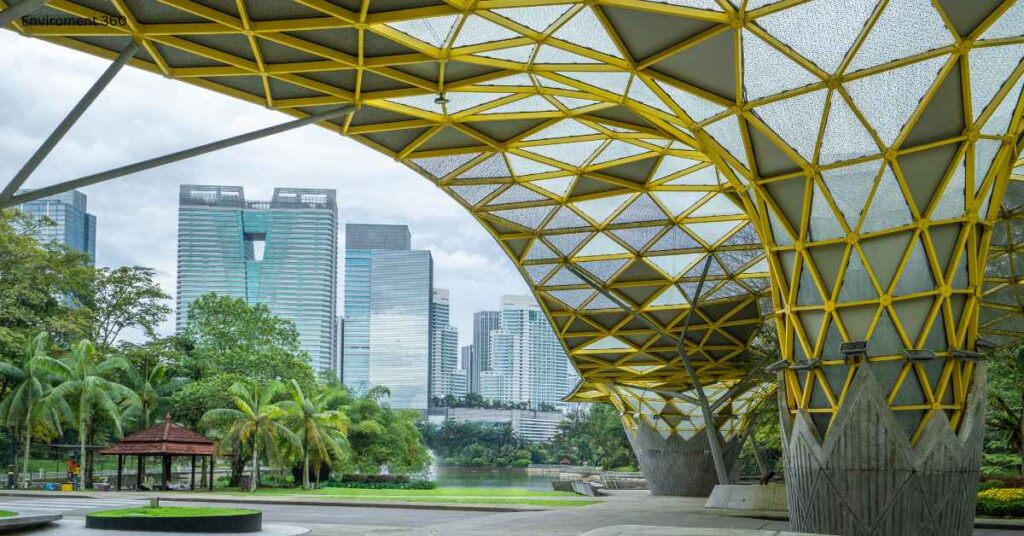In today’s world, where the fight against climate change and the push for environmental sustainability have become central, green lighting stands out as one of the most impactful solutions. Green lighting refers to the use of energy-efficient lighting technologies and practices that reduce environmental impact, save energy, and lower greenhouse gas emissions. This article will delve into the environmental benefits of green lighting, the various types of eco-friendly lighting technologies, and their role in shaping a sustainable future.
What is Green Lighting?
Green lighting is the implementation of lighting systems that are designed to minimize energy use and environmental impact. It focuses on enhancing lighting efficiency, reducing electricity consumption, and decreasing carbon footprints. The term encompasses a wide range of technologies, practices, and design approaches aimed at promoting sustainability in both residential and commercial environments.
The Importance of Green Lighting for the Environment
Traditional lighting methods, such as incandescent bulbs, consume large amounts of energy and contribute significantly to global electricity demand. The production and use of conventional lighting can lead to:
- Higher Carbon Emissions: Lighting accounts for a significant percentage of global electricity use, much of which is generated from fossil fuels.
- Increased Resource Consumption: Traditional lighting technologies require more resources for both production and operation.
- Waste Generation: Older lighting systems tend to have shorter lifespans, leading to more waste in landfills.
Green lighting offers a solution to these issues by providing energy-efficient alternatives that reduce power usage, lower operational costs, and have a smaller environmental impact.
Key Benefits of Green Lighting
1. Energy Efficiency
The most prominent advantage of green lighting is its energy efficiency. Traditional incandescent bulbs convert only about 10% of the energy they use into light, with the remaining 90% being wasted as heat. On the other hand, energy-efficient lighting options, such as LED (light-emitting diode) and CFL (compact fluorescent lamp) bulbs, can reduce energy consumption by up to 80%.
Environmental Impact
By using less energy, green lighting reduces the need for electricity generation from fossil fuels, thus cutting down on the emissions of greenhouse gases and other pollutants. This helps combat global warming and air pollution, promoting cleaner air and healthier ecosystems.
2. Longer Lifespan
Energy-efficient lighting options like LEDs last much longer than traditional incandescent bulbs. An LED bulb can have a lifespan of up to 25,000 hours, compared to the 1,000 hours typical of incandescent bulbs.
Environmental Impact
A longer lifespan means fewer bulbs are produced, transported, and disposed of. This reduces the amount of raw materials extracted for production, lowers carbon emissions associated with transportation, and cuts down on waste in landfills. Additionally, less frequent bulb replacement results in lower environmental costs related to manufacturing and shipping.
3. Reduced Heat Emissions
Incandescent bulbs produce a significant amount of heat during operation. This not only wastes energy but also increases cooling costs in buildings during warmer months.
Environmental Impact
Green lighting, particularly LEDs, generates very little heat, making them safer and more energy-efficient. This reduction in heat generation can also decrease the demand for air conditioning, which in turn lowers energy use and reduces the carbon footprint of buildings.
4. Cost Savings
While the upfront cost of green lighting technology may be higher than traditional bulbs, the long-term savings far outweigh the initial investment. Energy-efficient lighting can reduce energy bills by up to 75%, and the longer lifespan of these bulbs means fewer replacements are needed.
Environmental Impact
Lower energy bills translate to less energy consumption, which directly benefits the environment by reducing the demand for electricity. Over time, the cumulative effect of widespread green lighting adoption can lead to significant reductions in global energy consumption and greenhouse gas emissions.
Types of Green Lighting Technologies

1. Light-Emitting Diodes (LEDs)
LEDs are one of the most popular and energy-efficient lighting technologies available today. They produce light by passing an electric current through a semiconductor, which emits photons (light). Unlike traditional bulbs, LEDs do not rely on heating a filament to produce light, making them far more efficient.
Environmental Benefits of LEDs
- Energy Savings: LEDs consume up to 85% less energy than incandescent bulbs.
- Long Lifespan: LEDs can last 25 times longer than traditional lighting options, reducing waste.
- No Toxic Materials: Unlike CFLs, LEDs do not contain mercury or other harmful chemicals.
- Reduced Carbon Emissions: By lowering energy consumption, LEDs reduce the demand for electricity and help cut down on carbon emissions.
2. Compact Fluorescent Lamps (CFLs)
CFLs are another energy-efficient alternative to incandescent bulbs. They work by exciting gas inside a tube, which produces ultraviolet light that is then converted into visible light by a phosphor coating on the inside of the bulb.
Environmental Benefits of CFLs
- Energy Efficiency: CFLs use about 70% less energy than incandescent bulbs.
- Longer Lifespan: CFLs last about 10 times longer than traditional bulbs, reducing waste.
- Cost-Effective: Though slightly more expensive than incandescent bulbs, CFLs offer significant energy savings over time.
- Lower Carbon Footprint: CFLs’ energy efficiency leads to reduced demand for electricity and fewer greenhouse gas emissions.
However, it’s important to note that CFLs contain small amounts of mercury, which can be harmful to the environment if not disposed of properly.
3. Solar-Powered Lighting
Solar-powered lighting is an increasingly popular green lighting option, especially for outdoor applications. These lights are powered by solar panels that capture sunlight during the day and store it in batteries for use at night.
Environmental Benefits of Solar Lighting
- Completely Renewable Energy: Solar lighting systems do not require electricity from the grid, making them 100% renewable.
- No Greenhouse Gas Emissions: Since they do not use fossil fuels, solar lights produce zero greenhouse gas emissions.
- Low Maintenance: Solar lights are durable and require little maintenance, leading to less waste and lower environmental impact.
- Off-Grid Capabilities: Solar lights are ideal for remote areas with limited access to electricity, promoting sustainability in off-grid locations.
4. Motion-Sensor Lighting
Motion-sensor lighting is an energy-saving technology that only turns on when movement is detected in a specific area. This is particularly useful in places where lights are often left on unintentionally, such as parking lots, hallways, or outdoor spaces.
Environmental Benefits of Motion-Sensor Lighting
- Energy Efficiency: Motion-sensor lights only use energy when needed, reducing overall consumption.
- Reduced Light Pollution: By limiting lighting to times when it is necessary, motion-sensor systems help reduce light pollution.
- Cost Savings: Because these lights are not on continuously, they use less energy and save money on electricity bills.
- Longevity: The limited use of motion-sensor lights extends the lifespan of the bulbs, leading to less waste.
The Role of Green Lighting in Sustainable Architecture

Green lighting is a crucial component of sustainable architecture, which aims to reduce the environmental impact of buildings by optimizing energy use, minimizing waste, and enhancing the quality of indoor environments.
1. Daylighting
Daylighting is a green lighting strategy that takes advantage of natural sunlight to illuminate indoor spaces. By designing buildings with large windows, skylights, and reflective surfaces, architects can reduce the need for artificial lighting during daylight hours.
Environmental Benefits of Daylighting
- Energy Savings: By reducing the need for artificial lighting, daylighting lowers energy consumption.
- Improved Indoor Air Quality: Natural light enhances indoor air quality by reducing the use of energy-intensive HVAC systems.
- Well-Being: Exposure to natural light has been shown to improve human well-being, leading to increased productivity and lower stress levels.
2. Smart Lighting Systems
Smart lighting systems use sensors, timers, and automation to optimize energy use in buildings. These systems can adjust lighting levels based on occupancy, natural light availability, and time of day.
Environmental Benefits of Smart Lighting
- Energy Efficiency: Smart lighting ensures that lights are only on when needed, reducing energy waste.
- Reduced Carbon Footprint: By optimizing energy use, smart lighting systems help reduce the overall carbon footprint of buildings.
- Customizable Solutions: Smart lighting can be tailored to meet the specific needs of different environments, from homes to commercial spaces, enhancing energy savings.
The Future of Green Lighting
As the global demand for energy continues to rise, the need for sustainable solutions like green lighting becomes even more critical. Technological advancements are driving the development of even more energy-efficient lighting solutions, such as OLED (organic light-emitting diode) technology and light-harvesting systems.
1. OLED Technology
OLED lighting is an emerging green technology that offers even greater energy efficiency and flexibility than traditional LEDs. OLEDs produce light by passing electricity through organic compounds, which emit light as a result. This technology holds promise for creating ultra-thin, flexible lighting panels that can be integrated into various surfaces, from walls to windows.
2. Light-Harvesting Systems
Light-harvesting systems capture ambient light and redistribute it within buildings, further reducing the need for artificial lighting. This technology is being explored in green architecture to enhance the sustainability of building designs.
Conclusion
Green lighting is a powerful tool in the global effort to reduce energy consumption, lower carbon emissions, and protect the environment. Through the use of energy-efficient lighting technologies, sustainable architectural practices, and innovative solutions like daylighting and smart lighting systems, we can significantly decrease the environmental impact of lighting.
The adoption of green lighting on a large scale can lead to profound changes in how we use energy and interact with our environment. By making conscious choices about the lighting we use in our homes, workplaces, and public spaces, we can contribute to a brighter, more sustainable future for generations to come.
Read More: Environment One Pager: A Comprehensive Overview of Global Environmental Challenges and Solutions

